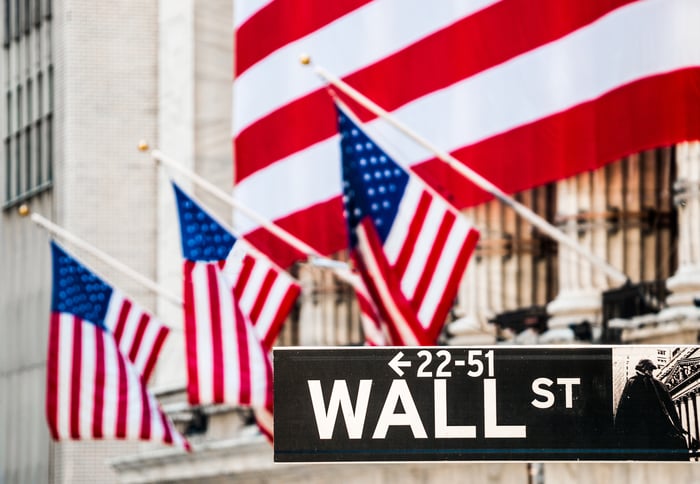Optimists looking for an encore performance from Wall Street were handsomely rewarded in 2024. Last year, the Dow Jones Industrial Average, S&P 500, and Nasdaq Composite all achieved multiple record-closing highs and ended higher by 13%, 23%, and 29%, respectively.
The fuel sparking this rally has been abundant, with strong corporate earnings, a resilient U.S. economy, a decline in the prevailing inflation rate, and Donald Trump's November victory all playing a role. But at the heart of this rally is the revolution and evolution of artificial intelligence (AI).

Image source: Getty Images.
AI is the game-changing technology that's giving software and systems the capacity to reason, act, and evolve, all without the need for human intervention. With AI offering utility in most industries around the globe, PwC foresees this technology increasing global gross domestic product (GDP) by 26% come 2030.
Although AI has been a boon for much of the tech sector, no company has more directly benefited than Nvidia (NVDA 0.40%).
Every Wall Street analyst expects Nvidia stock to rise
In a span of less than two years, we've witnessed Nvidia grow from a $360 billion business that was predominantly known for graphics processing units (GPUs) used in PC gaming and cryptocurrency mining to a $3.7 trillion company (at its peak) whose GPUs became the brains of enterprise-operated AI-accelerated data centers.
Demand for the company's ultra-popular Hopper (H100) chip and successor Blackwell GPU architecture have been otherworldly. Whereas Advanced Micro Devices has been pricing its Instinct MI300X AI-accelerating chips between $10,000 and $15,000, Nvidia's Hopper has been commanding a price tag of $30,000 to $40,000. This combination of AI-GPU scarcity and exceptional demand has boosted Nvidia's pricing power and gross margin.
NASDAQ: NVDA
Key Data Points
Additionally, no company has come particularly close to matching the computing potential of Nvidia's GPUs. The aforementioned Blackwell GPU is designed to accelerate computing in a half-dozen arenas, including quantum computing and generative AI solutions, and can do so while being considerably more energy efficient than its predecessor.
It's not just hardware, either, which is helping Nvidia hang onto its competitive advantages. The company's CUDA software platform, which is the toolkit developers use to maximize the computing potential of their Nvidia GPUs, has played a role in keeping customers loyal to its product and service ecosystem.
And, of course, Nvidia's operating results have consistently blown away the consensus expectations of Wall Street analysts. After reporting $27 billion in full-year sales in fiscal 2023 (ended Jan. 29, 2023), Nvidia is expected to deliver $129 billion in revenue for fiscal 2025. As you can imagine, nearly quintupling sales in two years has dramatically boosted its operating cash flow and profits.
Perhaps it's no surprise that every Wall Street analyst expects Nvidia stock to head higher. Out of the 40 analysts that have issued price targets, the lowest ($135 per share) implies 5% upside from where shares closed on Jan. 28. Further, out of the 67 analysts that have issued a buy, hold, or sell recommendation (not all analysts recommendations include a price target), not one rates Nvidia as the equivalent of an underperform or sell.
While this might sound like a resounding endorsement for Nvidia, it could be the ultimate contrarian indicator.

Image source: Getty Images.
Wall Street might have Nvidia all wrong
If history has proven anything, it's that Wall Street analysts tend to be reactive rather than proactive with their ratings. In other words, their rating adjusts after Nvidia delivers its quarterly operating results or its stock blows past a previous price target. Being reactive instead of proactive may be causing dozens of analysts to miss potentially serious red flags with Nvidia.
One of the biggest concerns analysts appear to be collectively overlooking is that history is undefeated when it comes to putting next-big-thing innovations in their place.
Approximately three decades ago, the proliferation of the internet provided a new way for businesses to market themselves and reach their customers. Eventually, the internet lifted the growth trajectory for American and global businesses. But this wasn't without the dot-com bubble taking place and wiping out 78% of the Nasdaq Composite's value on a peak-to-trough basis.
Every game-changing innovation for three decades has needed time to mature, without exception. Yet investors (including Wall Street analysts) have consistently overestimated the adoption rate and early stage utility of every next-big-thing innovation and trend.
Earlier this week, we had a perfect example of this overestimation in practice. When DeepSeek's open-source R1 large language model (LLM) rattled markets, investors briefly worried about an increase in AI competition (which is a point I'll touch on in a moment). But the bigger concern is it exposed the reality of most businesses not understanding what's needed to build and train LLMs. Put another way, most businesses lack a clear game plan with their AI investments and have no definitive idea of how to optimize AI solutions -- and that's a problem when Nvidia stock is priced for perfection.
Competition is also an inevitability that should weigh on Nvidia's gross margin. Though external competition from the likes of AMD will be a challenge, the more worrisome threat might come from Nvidia's largest customers by net sales. Microsoft, Meta Platforms, Amazon, and Alphabet are all internally developing AI chips to use in their data centers. Even if these chips pale in comparison to the computing potential of Nvidia's Hopper and Blackwell, they'll be significantly cheaper and more easily accessible than Nvidia's hardware.
The end of AI-GPU scarcity would be expected to erode Nvidia's juiced-up gross margin. NVDA Gross Profit Margin (Quarterly) data by YCharts.
A strong argument can be made that AI-GPU scarcity has been more important to Nvidia than its computing speed superiority. As this scarcity wanes in the quarters to come, Nvidia's pricing power, and thus its gross margin, could take a notable hit.
Wall Street analysts may not be properly accounting for geopolitical risks, as well. China is one of Nvidia's largest markets by net sales, and President Donald Trump's trade policies have the potential to strain trade relations between the world's two-largest economies by GDP. Mind you, the possibility of Trump implementing tariffs on China and/or foreign chipmakers comes atop the Joe Biden administration clamping down on AI-GPU exports since 2022.
Lastly, both Nvidia and the stock market, as a whole, are historically pricey. Nvidia topped a price-to-sales (P/S) ratio of 40 last summer, which is a level that's consistent with bubble-bursting events for businesses on the cutting edge of next-big-thing innovations.
Although every single analyst covering Nvidia expects its stock to head higher, there's compelling evidence to suggest they might all be wrong.





